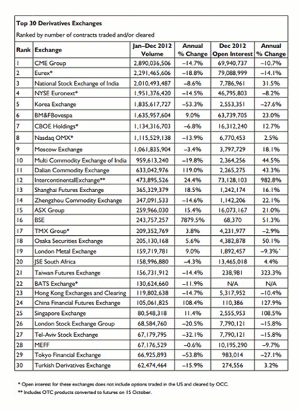For the benefit of traders just starting out in the realm of Options and Futures or for those in need of a refresher, Zaw Thiha Tun, at Investopedia.com, defines exchange-traded derivatives and provides a detailed analysis of the different types of exchange-traded options available.
An exchange-traded derivative is merely a derivative contract that derives its value from an underlying asset that is listed on a trading exchange and guaranteed against default through a clearinghouse. Due to its presence on a trading exchange, ETDs differ from over-the-counter derivatives in terms of their standardized nature, higher liquidity, and ability to be traded on the secondary market. ETDs include futures contracts, options contracts, and futures options. As of 2013, the World Federation of Exchanges reported that $22 billion derivative contracts were traded on exchanges around the world (12 billion futures and 10 billion options contracts), a noticeable increase of 685 million contracts from 2012.
A list of the top 30 derivatives exchanges can be viewed below:

Source: Chartered Institute for Securities & Investment (CISI)
Click to Enlarge
Futures
A futures contract is merely a contract specifying that a buyer purchase or a seller sell an underlying asset at a specified quantity, price, and date in the future. Futures are used by both hedgers and speculators to protect against or to profit from price fluctuations of the underlying asset in the future.
A myriad of products can be traded on the futures exchanges, with contracts ranging from agricultural products such as livestock, grains, soy beans, coffee, and dairy to lumber, gold, silver, copper to energy commodities such as crude oil and natural gas to stock indices and volatility indices such as the S&P, the Dow, Nasdaq ,and the VIX, as well as interest rates on Treasury notes and foreign exchange for a diverse array of major emerging markets and cross currency pairs. There are even futures based on forecasted weather and temperature conditions. Depending on the exchange, each contract is traded with its own specifications, settlement, and accountability rules. A list of the tradable futures contracts can be found on the CME Group’s Web site.
Options
Options are derivatives that grant the holder with the right, but not the obligation, to buy or sell an underlying asset at a pre-specified date and quantity. The options market has seen remarkable growth since the first standardized contract was traded in 1973. For instance, the Options Clearing Corporation reported clearing 3.9 billion contracts in 2010 and 4.33 billion in 2014. The Chicago Board Options Exchange (CBOE) is the largest options exchange in the world, with an average daily volume in 2014 of 5.3 million contracts being traded.
Types of Exchange-Traded Options
Equity Options are options in which the underlying asset is the stock of a publicly traded firm. Stock options are normally standardized in to 100 shares per contract, and the premium is quoted on a per-share basis. For instance, an Apple Inc. (AAPL) 115 strike call option for March 20 expiry is being traded for $12.15 per share or $1215 per option contract.
Index Options are options in which the underlying is asset is a stock index; the CBOE currently offers options on the S&P, Dow, FTSE, Russell, and the Nasdaq. Each contract had different specifications and can range in size from the approximate value of the underlying index to 1/10th the size. Currently, the CBOE has plans to offer options on MSCI Emerging Markets Index, starting in April 2015.
NEXT PAGE: Seven More Types of Exchange-Traded Options
|pagebreak|ETF Options are options in which the underlying is an exchange-traded fund.
VIX Options are unique options in which the underlying is the CBOE’s own index which tracks the volatility of the S&P 500 index option prices. The VIX can be traded via options and futures, as well as through options of the ETFs that track the VIX, such as the iPath S&P 500 VIX Short-Term Futures ETN (VXX).
Bond Options are options in which the underlying asset is a bond. The call buyer is expecting interest rates to decline/ bond prices to rise and the put buyer is expecting interest rates to climb/bond prices to fall.
Interest Rate Options are European-style, cash-settled options in which the underlying is an interest rate based on the spot yield of US Treasurys. Different options are offered for bills expiring at different time spans, e.g. a call buyer is expecting yields to rise and a put buyer is expecting yields to decline.
Currency Options are options in which the holder can buy or sell currency in the future. Currency options are used by individuals and major businesses to hedge against foreign exchange risk, for instance, if an American company is expecting to receive payment in euros in six months time and fears a drop in the EUR/USD, say from $1.06 per euro to $1.03 per euro, they can purchase a EUR/USD put with a strike of $1.05 per euro to ensure they can sell their euros at the spot market for a better price.
Weather Options and (futures) are used as hedges by companies to guard against unfavorable weather changes. They are not the same as catastrophe bonds that mitigate the risks associated with hurricanes, tornadoes, earthquakes, etc. Weather derivatives instead focus on daily or seasonal temperature fluctuations around a pre-determined temperature benchmark. More information on these derivatives can be found at the CME Group’s Web site.
Options on Futures: As previously mentioned, there are futures contracts for a variety of assets, and exchanges like the CME that offer options contracts on said futures. The futures options holder is entitled to buy or sell the underlying futures contract at the pre-specified date at a fraction of the margin requirement of the original futures contract.
The Bottom Line
Exchange-traded derivatives offer more liquidity, transparency, and lower counterparty risk than over-the-counter derivatives at a cost of contract customization. The exchange-traded derivatives world includes futures, options, and options on futures contracts.
By Zaw Thiha Tun, Contributor, Investopedia.com





















